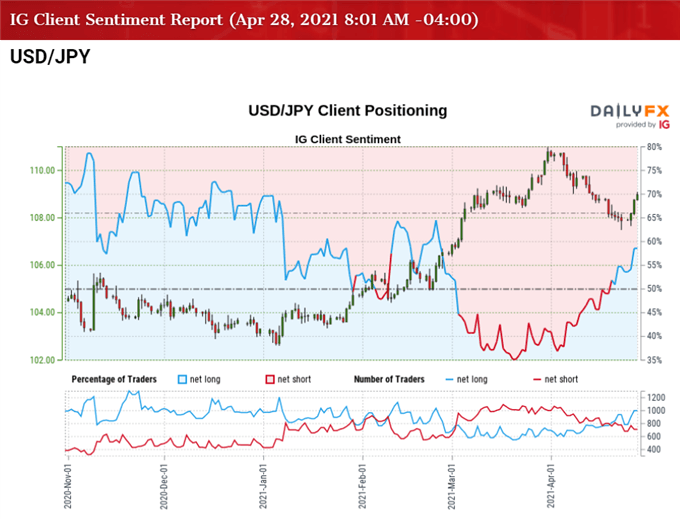Japanese Yen Talking Points
USD/JPY carves a series of higher highs and lows ahead of the Federal Reserve interest rate decision as the 10-Year US Treasury yield climbs to a fresh weekly high (1.65%), and the exchange rate may continue to retrace the decline from earlier this month if the central bank adopts a less dovish forward guidance for monetary policy.
USD/JPY Rate Tracks US Treasury Yields Ahead of FOMC Rate Decision
USD/JPY appears to have reversed course ahead of the March low (106.37) as it trades back above the 50-Day SMA (108.41), and it remains to be seen if the Fed rate decision will derail the recent advance in the exchange rate as a bull-flag formation appears to be playing out in the 10-Year US Treasury yield.
A continuation of the upward trend in longer-dated US yields may keep USD/JPY afloat even though the Federal Open Market Committee (FOMC) stays on track to “increase our holdings of Treasury securities by at least $80 billion per month and of agency mortgage-backed securities by at least $40 billion per month,” and a growing number of Fed officials may strike a less dovish tone over the coming months as the ongoing expansion in the central bank’s balance sheet boosts the outlook for growth and inflation.
However, the FOMC may tame speculation for a looming shift in monetary policy as Vice Chair Richard Clarida insists that “policy will not tighten solely because the unemployment rate has fallen below any particulareconometric estimate of its long-run natural level,” and the committee may keep the door open to further support the US economy as the central bank plans to “achieve inflation moderately above 2 percent for some time so that inflation averages 2 percent over time.”
As a result, USD/JPY may come under pressure if Chairman Jerome Powell and Co. strike a more dovish forward guidance, but the recent appreciation in the exchange rate may continue to coincide with the renewed in retail sentiment as the crowding behavior from 2020 resurfaces.
The IG Client Sentiment report shows 59.73% of traders are currently net-long USD/JPY, with the ratio of traders long to short standing at 1.48 to 1.
The number of traders net-long is 4.47% lower than yesterday and 26.93% higher from last week, while the number of traders net-short is 6.10% lower than yesterday and 14.74% lower from last week. The rise in net-long position comes as USD/JPY carves a series of higher highs and lows, while the decline in net-short interest has generated a further tilt in retail sentiment as 53.13% of traders were net-long the pair during the previous week.
With that said, it remains to be seen if the decline from the March high (110.97) will turn out to be a correction or a change in trend as the crowding behavior from 2020 resurfaces, but afurther rise in longer-dated US yields may prop up USD/JPY as the exchange rate appears to have reversed course ahead of the March low (106.37).
USD/JPY Rate Daily Chart
Source: Trading View
- USD/JPY approached pre-pandemic levels as a ‘golden cross’ materialized in March, with a bull flag formation unfolding during the same period as the exchange rate traded to a fresh yearly high (110.97).
- The Relative Strength Index (RSI) showed a similar dynamic as the indicator climbed above 70 for the first time since February 2020, but the pullback from overbought territory has negated the upward trend from this year, with USD/JPY dipping below the 50-Day SMA (108.41) for the first time since January.
- Nevertheless, USD/JPY appears to have reversed course ahead of the March low (106.37) as it climbs back above the 50-Day SMA (108.41), with the break/close above the Fibonacci overlap around 108.00 (23.6% expansion) to 108.40 (100% expansion) bringing the 109.40 (50% retracement) to 110.00 (78.6% expansion) region back on the radar.
- A break above the March high (110.97) opens up the overlap around 111.10 (61.8% expansion) to 111.60 (38.2% retracement), with the next area of interest coming in around 112.40 (61.8% retracement) to 112.50 (38.2% retracement).
— Written by David Song, Currency Strategist
Follow me on Twitter at @DavidJSong




Be the first to comment